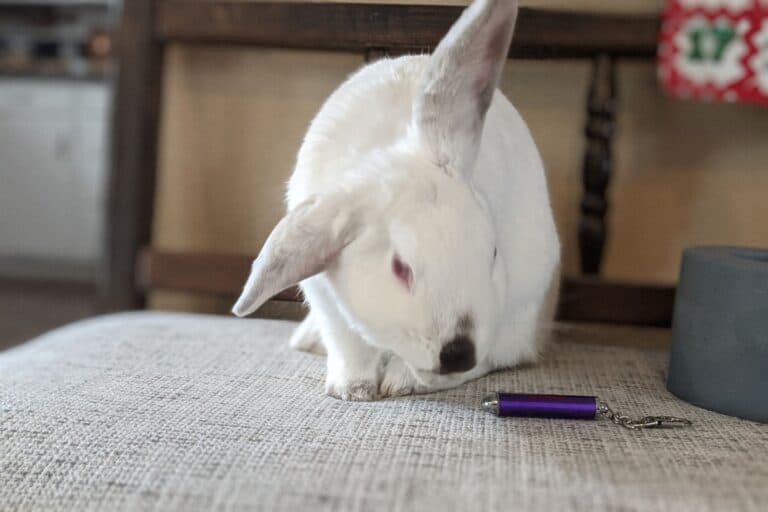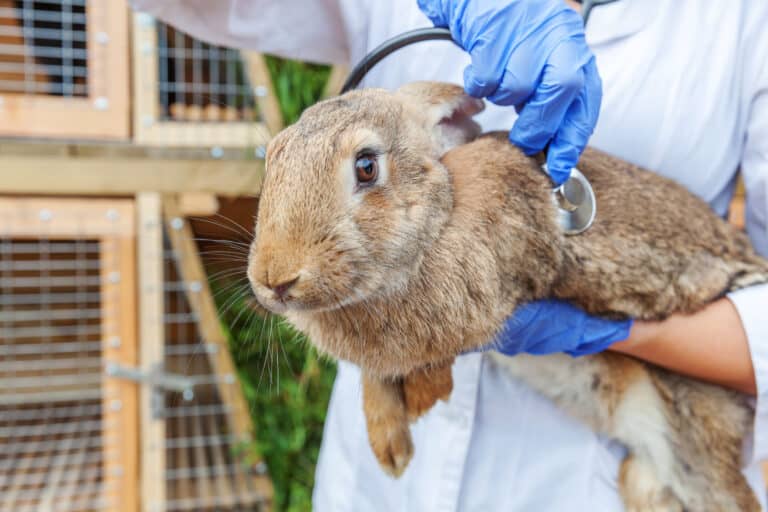Rabbit Ear Mites: 4 Signs to Watch For and How to Treat It

Even if you’re the most devoted bun parent in the world, your rabbit can still get ear mites. That’s because those troublesome buggers can move from rabbit to rabbit pretty quickly, and since buns have sensitive ears, they are prone to infections that mites can cause. But don’t despair. Rabbit ear mite infestations may be common, but effective treatments for the condition exist. However, you’ll need to know what signs to look out for so you can immediately seek treatment for your pet. So let’s take a closer look at what they are, what they mean for rabbits and how to treat it.
What Exactly Are Rabbit Ear Mites?
The critters that cause the bothersome condition are called Psoroptes Cuniculi. This type of mite is either brown or black colored and is barely visible to the naked eye. The mites’ droppings and saliva cause an inflammatory reaction which makes your bun itch.
A single infected ear can harbor up to 10,000 mites, so you can imagine the damage and misery these pests can inflict on your fur baby.

What Does This Mean for Rabbits?
The inflammation caused by the mites itch like crazy and is painful to boot, so you can’t blame your bun for rubbing or scratching his ears. The problem is, rubbing or scratching tends to spread the infection to other parts of the body and add to your bun’s woes.
Because of the pain and severe itching, your pet may stop eating, which, in turn, can lead to the potentially fatal condition called gut stasis or gastrointestinal (GI) stasis.
The self-trauma caused by the itching and scratching may lead to the formation of scaly brown crusts in the ear lining, and if the infection spreads to the inner ear, it can result in a ruptured eardrum.
What Are the Signs That Your Rabbit Has Ear Mites?
The following are the typical signs of an ear mite infestation:
1. Skin Inflammation and Scratching
At first, you’ll likely see some scaling and flaking of the skin inside the ear flap. Skin redness may also be present. As the infestation progresses, your bun will start scratching and overgrooming himself, which sometimes lead to fur loss and oozing wounds in some parts of his body.
2. Head Shaking
The mites’ droppings and body fluids may cause severe itching in your rabbit’s ear. Your bun can’t scratch his ear, so he shakes his head instead. An infection in the inner ear can be painful, leading your fur baby to shake his head to try and ease the discomfort.
3. Discharge Around the Ears
Due to the inflammation caused by the saliva and feces of ear mites, serum and white blood cells ooze onto the lining of the ears. This produces a yellow or brown liquid that sticks to your pet’s skin and hair. Often referred to as canker, these brown crusts eventually cause the ear to droop as the scabbing increases.
4. Head Tilt
If the brown crusts or ear canker is left untreated, it can bring on secondary bacterial infections where head tilting is one symptom. Other signs of an ear infection include loss of balance and a foul smell in the ear.
What Can Cause a Rabbit Ear Mite Infestation?
Like we mentioned before, ear mites are very contagious, so they spread so quickly. Here are some of the ways your fur baby can catch them.
- Through direct contact: The mites can quickly jump from an infected rabbit onto your pet.
- In the environment: Ear mites can survive for days, or even weeks, away from their host animal depending on certain conditions like temperature and humidity. So if your bun strays into an area where an infected rabbit stayed, your pet can catch mites. One method of transmission is through the flakes shed by the bun with an ear mite infestation.
- Through people: If you handle more than one rabbit, you can transfer the ear mites from one bun to another as these pests can hitch a ride on your hands or clothes.

How to Treat Your Rabbit’s Ear Mite Infestation?
Getting rid of your bun’s ear mites requires a visit to a vet for prescription medication. Ear mites are not to be taken lightly so if you suspect ear mites in your rabbit, make an appointment for a vet check immediately. They will likely prescribe a two-pronged approach:
1. Treat Your Rabbit
Typically there are two options for this…
- Topical treatment: This requires applying the medication to the affected area. The antiparasitic medicines come in the form of powders, drops, or oils.
- Systemic treatment: This treatment option uses injectable, oral, or dermal absorbed antiparasitic medications. It is the more preferred way of treating ear mites because it is easier to administer, requires fewer repetitions, and brings better results.
Drugs that contain the avermectin compound work well in treating rabbit ear mite infestations. These medications include selamectin and ivermectin.
2. Treat the Environment
On its own, using antiparasitic medications on your bun won’t be that effective in getting rid of ear mites. You’ll also need to treat the environment or the area where your pet stays.
Here are some things to consider for this task.
- If you have a bonded pair, it’s likely that both rabbits have ear mites. So it’s not necessary to separate them. However, to prevent reinfestation, you’ll need to clean the enclosure daily during treatment and use disposable material that’s easily thrown away. Remember that the pests usually live for up to three weeks without a host animal.
- Throw away the bedding and replace it with a fresh one. Also, treat the cage with a rabbit-friendly insecticide. However, with some material, like wood, for example, completely eliminating the mites might prove to be too much of a challenge. As such, it might be easier to simply replace the cage.
- If your pet’s habitat is in an area that’s accessible to wild animals, consider relocating your fur baby’s living environment to prevent mites from other animals from getting to your rabbit.
Left untreated, a mite infestation is not only uncomfortable for your rabbit, but the condition can also lead to health issues like gut stasis, weight loss, and secondary infections. That’s why if you suspect that your bun has mites, you should seek the advice of a rabbit-savvy vet on the best way to treat the infestation.
Ear Mites in Rabbits FAQs
No. Ear mites are a condition to be taken seriously and require prescription strength medication to completely get rid of the problem.
Ear mites are extremely contagious.
Absolutely. In multi-pet households, all pets will need to be checked and /or treated for ear mites.
It’s likely that if one rabbit has ear mites, the other one does as well. So it’s not necessary to separate them since they will both be treated equally. Their enclosure will need to be cleaned daily as outlined in the Treatment section above.
More on Rabbit Care
- How Long Do Flemish Rabbits Live: Giant Breed Facts
- Complete Guide to the Best Hay For Rabbits: Reviews & More
- Are Rabbits Rodents? Find Out More About These Small Mammals
- Is Oat Hay Good for Rabbits? Complete Guide to the Best Hay
- Why Do Rabbits Lick You? 11 Reasons for This Common Behavior
We hope you enjoyed this post! If you did, will you give it a share or two 🙂 Thank you! ~from Every Bunny Welcome







